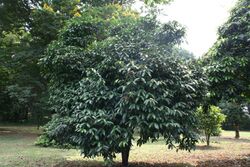Chemistry:Akuammicine

| |
| Names | |
|---|---|
| IUPAC name
Methyl (19E)-2,16-didehydrocur-19-en-17-oate
| |
| Identifiers | |
3D model (JSmol)
|
|
| ChEBI | |
| ChemSpider | |
PubChem CID
|
|
| UNII | |
| |
| |
| Properties[1] | |
| C20H22N2O2 | |
| Molar mass | 322.408 g·mol−1 |
| Appearance | Colourless solid |
| Melting point | 182 °C (360 °F; 455 K) |
| Acidity (pKa) | 7.45 |
Except where otherwise noted, data are given for materials in their standard state (at 25 °C [77 °F], 100 kPa). | |
| Infobox references | |
Akuammicine is a monoterpene indole alkaloid of the Vinca sub-group. It is found in the Apocynaceae family of plants including Picralima nitida,[1][2] Vinca minor and the Aspidosperma.[3]
History
The alkaloids are a large group of natural products which are classified according to the part-structure which members of a particular group contain. Akuammicine is a monoterpene indole alkaloid of the Vinca sub-group which shares a common biosynthesis with other members, namely that they are derived from strictosidine.[4][5] It was first isolated in 1927 and had been investigated by Sir Robert Robinson and others before its structure was correctly deduced.[1][6][7] This was confirmed by X-ray crystallography in 2017.[8]
Natural occurrence
Akuammicine is found in plants of the Apocynaceae family and was first isolated from Picralima nitida.[1][2] It has also been reported in Catharanthus roseus.[9]
Synthesis
Biosynthesis
As with other indole alkaloids, the biosynthesis of akuammicine starts from the amino acid tryptophan. This is converted into strictosidine before further elaboration.[4]
Chemical synthesis
Akuammicine has been a target for total synthesis,[10] partly because of its relationship to the well-known alkaloid strychnine which has often attracted chemists in academia.[11][12][13][14]
Research
Plant metabolites have long been studied for their biological activity and alkaloids in particular are major subjects for ethnobotanical research.[15] Akuammicine is reported to have effects on glucose uptake[2] and be a κ- and μ-opioid receptor agonist.[3][16]
See also
- Ajmalicine
- Vinervine, the 12-hydroxy derivative
References
- ↑ 1.0 1.1 1.2 1.3 Robinson, Robert; Thomas, A. F. (1955). "The Alkaloids of Picralima nitida, Stapf, Th. and H. Durand. Part III. A Note on Akuammicine and pseudoAkuammicine.". Journal of the Chemical Society (Resumed): 2049. doi:10.1039/jr9550002038. ISSN 0368-1769.
- ↑ 2.0 2.1 2.2 Shittu, Hafsat; Gray, Alexander; Furman, Brian; Young, Louise (2010). "Glucose uptake stimulatory effect of akuammicine from Picralima nitida (Apocynaceae)". Phytochemistry Letters 3 (1): 53–55. doi:10.1016/j.phytol.2009.11.003. ISSN 1874-3900.
- ↑ 3.0 3.1 Mitaine, A. C.; Mesbah, K; Richard, B; Petermann, C; Arrazola, S; Moretti, C; Zèches-Hanrot, M; Men-Olivier, L. L. (1996). "Alkaloids from Aspidosperma species from Bolivia". Planta Medica 62 (5): 458–61. doi:10.1055/s-2006-957939. PMID 17252481.
- ↑ 4.0 4.1 Dewick, Paul M (2002). Medicinal Natural Products. A Biosynthetic Approach. Second Edition. Wiley. pp. 350–359. ISBN 0-471-49640-5. https://books.google.com/books?id=A4zptjOJfKQC&pg=PP1.
- ↑ Saxton, J. E. (1984). "Recent progress in the chemistry of indole alkaloids and mould metabolites". Natural Product Reports 1: 21. doi:10.1039/NP9840100021.
- ↑ Smith, G. F.; Wróbel, J. T. (1960). "161. Akuamma alkaloids. Part I. Akuammicine". J. Chem. Soc.: 792–795. doi:10.1039/JR9600000792.
- ↑ Yagudaev, M. R. (1983). "NMR investigation of alkaloids. IV. 13C NMR spectra and structures of norfluorocurarine, akuammicine, vincanidine, and vinervinine". Chemistry of Natural Compounds 19 (2): 199–201. doi:10.1007/BF00580558.
- ↑ Yahyazadeh, Mahdi; Jerz, Gerold; Selmar, Dirk; Winterhalter, Peter; Jones, Peter G. (2017). "Crystal structure of akuammicine, an indole alkaloid from Catharanthus roseus". Acta Crystallographica Section E 73 (11): 1658–1661. doi:10.1107/S2056989017014529. PMID 29152344.
- ↑ Scott, A.Ian; Mizukami, Hajime; Hirata, Toshifumi; Lee, Siu-Leung (1980). "Formation of catharanthine, akuammicine and vindoline in Catharanthus roseus suspension cells". Phytochemistry 19 (3): 488–489. doi:10.1016/0031-9422(80)83216-X.
- ↑ Jones, Spencer B.; Simmons, Bryon; Mastracchio, Anthony; MacMillan, David W. C. (2011). "Collective synthesis of natural products by means of organocascade catalysis". Nature 475 (7355): 183–188. doi:10.1038/nature10232. PMID 21753848.
- ↑ Ito, Masayuki; Clark, Cameron W.; Mortimore, Michael; Goh, Jane Betty; Martin, Stephen F. (2001). "Biogenetically Inspired Approach to the Strychnos Alkaloids. Concise Syntheses of (±)-Akuammicine and (±)-Strychnine". Journal of the American Chemical Society 123 (33): 8003–8010. doi:10.1021/ja010935v. PMID 11506556.
- ↑ Sirasani, Gopal; Paul, Tapas; Dougherty, William; Kassel, Scott; Andrade, Rodrigo B. (2010). "Concise Total Syntheses of (±)-Strychnine and (±)-Akuammicine". The Journal of Organic Chemistry 75 (10): 3529–3532. doi:10.1021/jo100516g. PMID 20408591.
- ↑ Sirasani, Gopal; Andrade, Rodrigo B. (2013). Total Synthesis of Strychnos Alkaloids Akuammicine, Strychnine, and Leuconicines a and B. Strategies and Tactics in Organic Synthesis. 9. pp. 1–44. doi:10.1016/B978-0-08-099362-1.00001-1. ISBN 9780080993621.
- ↑ Feng, Liang-Wen; Ren, Hai; Xiong, Hu; Wang, Pan; Wang, Lijia; Tang, Yong (2017). "Reaction of Donor-Acceptor Cyclobutanes with Indoles: A General Protocol for the Formal Total Synthesis of (±)-Strychnine and the Total Synthesis of (±)-Akuammicine". Angewandte Chemie International Edition 56 (11): 3055–3058. doi:10.1002/anie.201611734. PMID 28170147.
- ↑ Babiaka, Smith B.; Ntie-Kang, Fidele; Lifongo, Lydia L.; Ndingkokhar, Bakoh; Mbah, James A.; Yong, Joseph N. (2015). "The chemistry and bioactivity of Southern African flora I: A bioactivity versus ethnobotanical survey of alkaloid and terpenoid classes". RSC Advances 5 (54): 43242–43267. doi:10.1039/C5RA01912E. Bibcode: 2015RSCAd...543242B.
- ↑ Menzies, John R.W; Paterson, Stewart J.; Duwiejua, Mahama; Corbett, Alistair D. (1998). "Opioid activity of alkaloids extracted from Picralima nitida (Fam. Apocynaceae)". European Journal of Pharmacology 350 (1): 101–108. doi:10.1016/s0014-2999(98)00232-5. PMID 9683021.



